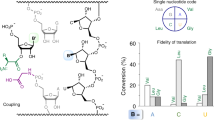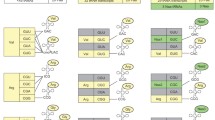Summary
The in vitro B. subtilis protein synthesizing system is very restricted in its ability to translate E. coli phage messenger RNA's, specifically phage T4 RNA, even though it actively translates its proper mRNA species. In contrast, the E. coli system translates with similar efficiency mRNA from either source. The initiation factors from the two systems are functionally interchangeable. The 30S B. subtilis ribosomal subunit is responsible for the limited template specificity of the B. subtilis ribosomes. Although the efficiency of the T4RNA directed F Met-tRNA binding by B. subtilis ribosomes is less than that of SPOI RNA-directed binding, the most restrictive step in the translation of T4 RNA by B. subtilis ribosomes appears to be at the level of the formation of the first peptide bond, as measured by F Metpuromycin formation.
Similar content being viewed by others
References
Bolle, A., Epstein, R. H., Salser, W.: Transcription during bacteriophage T4 development: synthesis and relative stability of early and late RNA. J. molec. Biol. 31, 325–348 (1968)
Bowman, C. M., Dahlbert, J. E., Ikemura, T., Konisky, J., Nomura, M.: Specific inactivation of 16S ribosomal RNA induced by colicin E3 in vivo. Proc. nat. Acad. Sci. (Wash.) 68, 964–968 (1971)
Bray, G. A.: A simple efficient liquid scintillator for counting aqueous solutions in a liquid scintillation counter: Analyt. Biochem. 1, 279–285 (1960)
Byefield, J. E., Sogerbaum, O. H.: A rapid radioassay technique for cellular suspensions. Analyt. Biochem. 17, 434–443 (1966)
Cammack, K. A., Wade, H. E.: The sedimentation behaviour of ribonuclease active and inactive ribosomes from bacteria. Biochem. J. 96, 671–680 (1965)
Expert-Besançon, A., Guerin, M. F., Hayes, D. H., Legault, L., Thibault, J.: Preparation of E. coli ribosomal subunits without loss of biological activity. Biochimie 56, 77–89 (1974)
Gesteland, R. F.: Isolation and characterization of ribonuclease I mutants of Escherichia Coli. J. molec. Biol. 16, 67–84 (1966)
Gualerzi, C., Pon, C. L., Kaji, A.: Initiation factor dependent release of aminoacyl-tRNAs from complexes of 30S ribosomal subunits, synthetic polynucleotide and aminoacyl tRNA. Biochem. biophys. Res. Commun. 45, 1312–1319 (1971)
Helser, T. L., Davies, J. E., Dahlberg, J. E.: Change in methylation of 16S ribosomal RNA associated with mutation to Kasugamycin resistance in Escherichia coli. Nature (Lond.) New Biol. 233, 12–14 (1971)
Himes, R. H., Stallcup, M. R., Rabinowitz, J. C.: Translation of synthetic and endogenous messenger ribonucleic acid in vitro by ribosomes and polyribosomes from Clostridium pasteurianum. J. Bact. 112, 1057–1069 (1972)
Lazar, D., Gros, F.: Translation initiation defects in ribosomes from streptomycin dependent strains. Biochimie 55, 171–181 (1973)
Leder, P., Bursztyn, H.: Initiation of protein synthesis. II: A convenient assay for the ribosome dependent synthesis of N-formyl-C14-methionyl puromycin. Biochem. biophys. Res. Commun. 25, 233–238 (1966)
Leffler, S., Szer, W.: Messenger selection by bacterial ribosomes. Proc. nat. Acad. Sci. (Wash.), 70, 2364–2368 (1973)
Leffler, S., Szer, W.: Purification and properties of initiation factor IF-3 from Caulobacter crescentus. J. biol. Chem. 249, 1458–1464 (1974)
Legault-Démare, L., Chambliss, G. H.: A natural messenger RNA directed cell free protein synthesizing system of B. subtilis. J. Bact. 120, 1300–1307 (1974)
Lelong, J. C., Cousin, M. A., Gros, D., Grunberg-Manago, M., Gros, F.: Streptomycin induced release of fMet-tRNA from ribosomal initiation complex. Biochem. biophys. Res. Commun. 42, 530–537 (1971)
Lelong, J. C., Grunberg-Manago, M., Dondon, J., Gros, D., Gros, F.: Interaction between guanosine derivatives and factors involved in the initiation of protein synthesis. Nature (Lond.) 226, 506–510 (1970)
Lodish, H. F.: Species specificity of polypeptide chain initiation. Nature (Lond.) 224, 867–870 (1969)
Lodish, H. F.: Specificity in bacterial protein synthesis: role of initiation factors and ribosomal subunits. Nature (Lond.) 226, 705–707 (1970)
Nomura, M.: Editorial. Nature (Lond.) New Biol. 246, 129–131 (1973)
Revel, M., Pollack, Y., Groner, Y., Scheps, R., Inouye, H., Berissi, H., Zeller, H.: IF3-interference factors: protein factors in Escherichia coli controlling initiation of mRNA translation. Biochimie 55, 41–51 (1973)
Sekiguchi, M., Cohen, S. S.: The synthesis of messenger RNA without protein synthesis. II.: Synthesis of phage-induced RNA and sequential enzyme production. J. molec. Biol. 8, 638–659 (1964)
Shine, J., Dalgarno, L.: The 3′-terminal sequence of Escherichia coli 16S ribosomal RNA: complementarity to nonsense triplets and ribosome binding sites. Proc. nat. Acad. Sci. (Wash.) 71, 1342–1346 (1974)
Stallcup, M. R., Rabinowitz, J. C.: Initiation of protein synthesis in vitro by a Clostridial system I: specificity in the translation of natural messenger ribonucleic acids. J. biol. Chem. 248, 3209–3215 (1973a)
Stallcup, M. R., Rabinowitz, J. C.: Initiation of protein synthesis in vitro by a Clostridial system II: the roles of initiation factors and salt-washed ribosomes in determining specificity in the translation of natural messenger ribonucleic acids. J. biol. Chem. 248, 3216–3219 (1973b)
Steitz, J. A.: Discriminatory ribosome rebinding of isolated regions of protein synthesis initiation from the ribonucleic acid of bacteriophage R17. Proc. nat. Acad. Sci. (Wash.) 70, 2605–2609 (1973)
Szer, W., Brenowitz, J.: Translation of MS2 RNA by ribosomes from different bacterial species. Biochem. biophys. Res. Commun. 38, 1154–1160 (1970)
Tai, P. C., Wallace, B. J., Davis, B. D.: Actions of aurintricarboxylate, kasugamycin and pactamycin on Escherichia coli polysomes. Biochemistry 12, 616–620 (1973)
Author information
Authors and Affiliations
Additional information
Communicated by F. Gros
Rights and permissions
About this article
Cite this article
Legault-Démare, L., Chambliss, G.H. Selective messenger translation by Bacillus subtilis ribosomes. Molec. Gen. Genet. 142, 277–287 (1975). https://doi.org/10.1007/BF00271252
Received:
Issue Date:
DOI: https://doi.org/10.1007/BF00271252




